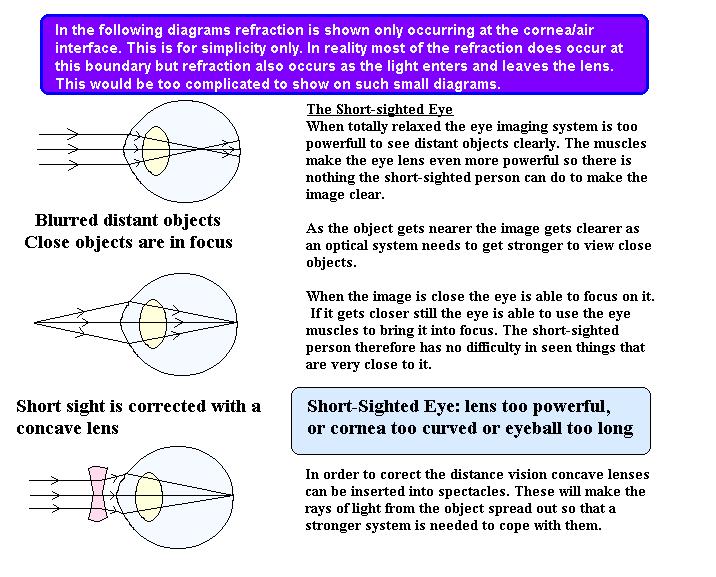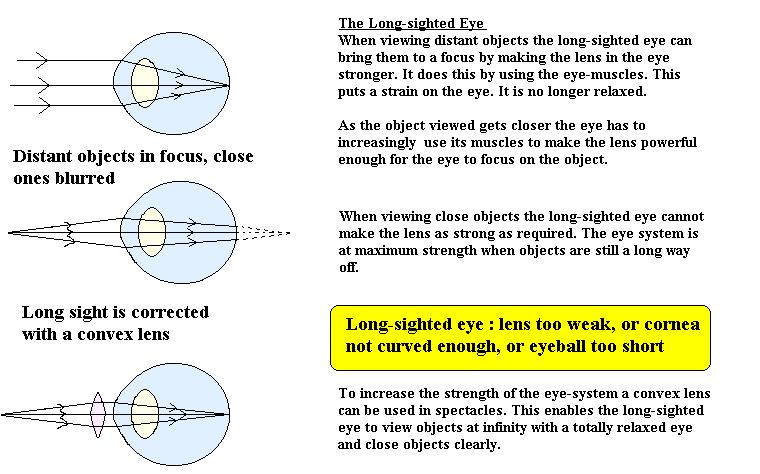|
You
are expected to be able to draw simple diagrams to represent the
passage of light through the eye
|
- Make
sure that your diagrams clearly show which way the curved surfaces
make the light bend!
- It
is good practice to continue the path of a ray through the boundary
with a dotted line, draw in a normal to the surface and then draw
in the refracted ray
- The
diagrams below do NOT do this - the computer drawn images would
have been too cluttered.. but you should practice drawing these
diagrams until you can draw them easily and clearly
|
(NB Refraction
is only shown at the air/cornea boundary)
You are expected to
know:
- What happens to
rays of light passing through a normal, short-sighted and long-sighted
eye.
- What type of lens
is required to correct sight defects.
- How to draw a
ray diagram to show the correction
- To understand the problems associated with lens use - see aberration.
Sight
Correction Diagrams


Wearing
glasses
When you wear glasses
you see the images of the objects not the objects themselves!
The images you see are upright and on the same side of the lens
as the objects - therefore the image you see is virtual (its distance
has a negative sign). The object distances have a positive sign.
In order to see clearly the image has to be within your range of clear
vision (between your near and far points).
Long Sight
A long sighted person
cannot see things clearly if they are close to them. Someone with normal
sight sees an object when it is only 25 cm from their eye. To a long sighted
person that would be blurred. When a person with long sight puts on their
spectacles they are able to see objects that are placed at the normal
near point.
How does this happen?
Well, the lenses make
the image of the object placed at the near point appear to be at the person's
actual near point. For example: if a person has an unaided near point
of 0.60m they need a convex lens in their glasses to make them able to
see clearly an object that is only 25 cm from their eyes. What would be
the power of this lens?
The object distance
(u) is 25 cm as the object is actually that far from the person's eyes.
The image distance (v) has to be 60 cm as that is the closest distance
the person's eyes can focus on.
The image has to be the 'right way up' and 'on the same side of the lens
as the object' so it will be virtual.
The lens is convex so the focal length is positive.
So, we
have:
u = +0.25 m
v = - 0.60 m
P =
1/f = 1/v + 1/u
= -1/0.60 + 1/0.25
= + 2.3 D
f =
1/P = 0.43 m
Wearing these spectacles
will have an effect on the way you view distant objects. It alters the
power of the optical system you are using to see with.
The most relaxed your
eye can be (flattest lens shape - no use of muscles to squeeze the lens)
is when rays that are coming from infinity enter your eye. An object placed
at the focal point of a convex lens produces parallel rays so the far
point of vision with these glasses on will be the focal length of the
lens itself.
Therefore the far
point of a person when wearing the lens will be 0.43 m and the range of
clear vision will be 25cm to 43 cm.
Short sight
A short sighted person
cannot see things clearly if they are far away from them. Someone with
normal sight sees an object when it is at infinity. To a short sighted
person that would be blurred. When a person with short sight puts on their
spectacles they are able to see objects that are placed at the normal
far point - infinity.
How does this happen?
Well, the lenses make
the image of the object placed at the infinity appear to be at the person's
actual far point. For example: if a person has an unaided far point of
0.60m they need a concave lens in their glasses to make them able to see
clearly an object that is at infinity. What would be the power of this
lens?
The object distance
(u) is infinity as the object is actually that far from the person's eyes.
The image distance (v) has to be 60 cm as that is the closest distance
the person's eyes can focus on.
The image has to be the 'right way up' and 'on the same side of the lens
as the object' so it will be virtual.
The lens is concave so the focal length is negative.
So, we have:
u = infinity and 1/u = 0
v = - 0.60 m
P =
1/f = 1/v + 1/u
= -1/0.60 + 0
= - 1.7 D
f =
1/P = -0.60 m
Wearing these spectacles
will have an effect on the way you view close objects. It alters the power
of the optical system you are using to see with.
The most stressed
your eye can be (fattest lens shape - maximum use of muscles to squeeze
the lens) is when rays that are coming from close up to enter your eye.
Let
us suppose that the near point of the short sighted person is 20cm. Then
the closest an object can be clearly viewed from will be:
f = -0.60 m
v = - 0.20 m
1/f
= 1/v + 1/u
-1/0.60 = - 1/0.20 + 1/u
1/u = + 3.33
u = 0.30 m
Therefore the near
point of the person when wearing the lens will be 0.30 m and the range
of clear vision will be 30 cm to infinity.
|










